|
Advantech AIMB-210
A low power Intel Atom-based Mini-ITX motherboard for industrial and embedded applications that require fanless operation
(by Conrad H. Blickenstorfer)
Most people don't spend a lot of time thinking about computer motherboards. They are just inside the PC and do their job. To system integrators, however, the choice of the right motherboard is a big issue. Here are some of the criteria for selecting a motherboard:
- Space considerations
- Processor and chipset technology
- Power requirements
- Interface requirements
- Standards support
There are, in fact, about two dozen different computer board form factors. Not all of them are full motherboards. Sometimes, system integrators prefer to use Computer On Module (COM) technology where the generic computing "engine" resides on a separate board that is then plugged into a "carrier" board designed for some specific purpose. This way, system integrators can select the right COM for a complex embedded systems project and then concentrate on their application rather than having to design an entire computer from scratch, saving as much as 80% of the regular development time and cost.
Other times the task at hand can best be filled by a fully integrated conventional motherboard, but there are very detailed requirements and space is an issue. In that case, you'd be looking for a board with just the right functionality that also fits into the alloted space. For example, let's assume an application requires targeted computing power, sufficient memory, support of multiple displays, multiple disks, dual high speed Ethernet ports, as many USB ports as possible, and also extensive legacy support. Noise, heat generation and power consumption are all issues. The system should also be bootable from CompactFlash and the board's footprint shouldn't be larger than about seven by seven inches. There is no need for more than one expansion slot. Enter...
The Advantech AIMB-210 Mini-ITX board
A possible answer would be an Intel Atom-powered Mini-ITX board such as the Advantech AIMB-210 shown below. The Mini-ITX form factor has been around since 2001 and specifies a 17 x 17 centimeter (6.7 x 6.7 inches) low-power board. It was originally conceived for entry-level platforms and industrial applications. Unlike some more exotic board types, Mini-ITX board fit into generic computer cases and they use the same screw-mount patterns. Their small size and low power requirements, however, mean that they are perfect for custom applications where a standard PC needs to fit into a small space.
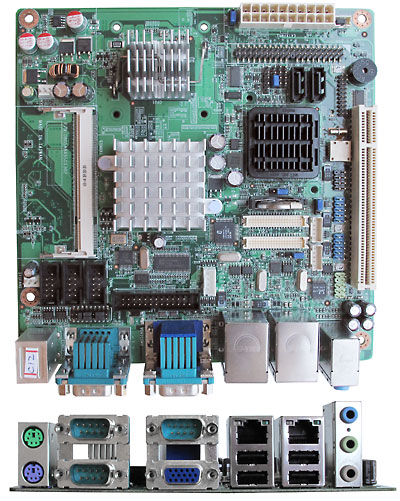 The Advantech AIMB-210 shown here brings the Intel Atom processor to Mini-ITC motherboards. It includes the 1.6GHz Atom N270 processor that is being used in millions of netbooks, an extremely power-efficient solution with a thermal design power of just 2.5 watts. The board uses an Award BIOS and the Intel 945GSE graphics and memory controller with the ICH7M controller hub. There is a single PCI expansion slot. RAM is provided via one 200-pin SODIMM slot that accommodates up to 2GB of 533 DDR2 SDRAM. The Advantech AIMB-210 shown here brings the Intel Atom processor to Mini-ITC motherboards. It includes the 1.6GHz Atom N270 processor that is being used in millions of netbooks, an extremely power-efficient solution with a thermal design power of just 2.5 watts. The board uses an Award BIOS and the Intel 945GSE graphics and memory controller with the ICH7M controller hub. There is a single PCI expansion slot. RAM is provided via one 200-pin SODIMM slot that accommodates up to 2GB of 533 DDR2 SDRAM.
The AIMB-210 has onboard graphics using the Intel 945GSE GMCH integrated Graphics Media Accelerator 950 that supports up to 224MB of shared system video RAM. Dual displays are supported via a standard rear I/O VGA and an internal LVDS connector on the board itself. There is also TV-out, and a second LVDS port is optionally available.
The board supports 10/100/1000Base-T gigabit Ethernet, and there are two RJ45 jacks on the rear I/O panel. Both LAN1 and LAN2 use Realtek RTL8111C controllers.
For disks and other drives, the board offers a single Ultra DMA 100 EIDE interface as well as two 150 MB/s SATA channels. For solid state disk systems, the board also has a single Compact Flash slot for Type I/II CF cards. It is on the bottom side of the board and the system can boot off it.
The rear I/O panel has four USB 2.0 ports, two legacy PS/2 ports for keyboard and mouse, and three RS232 serial ports. What you see on the rear I/O panel, however, is only part of what the AIM-210 offers. On the board itself are four more USB 2.0 connectors, three additional RS232 serial connectors, the LVDS and Inverter port, as well as an 8-line Digital I/O (DIO) connector.
Anyone who has ever built their own PC from parts knows about the system panel connector that interacts with buttons and lights on the case or enclosure. It connects to the system power LED, reset button, power button, and hard disk activity light. That's no different on a Mini-ITX board.
The BIOS offers the usual wealth of setup options, both the common sense stuff and the arcane settings that sometimes make all the difference between an optimized system and one that tends to act up.
What's in the box
Here is what Advantech ships when you buy the AIMB-210 for your project: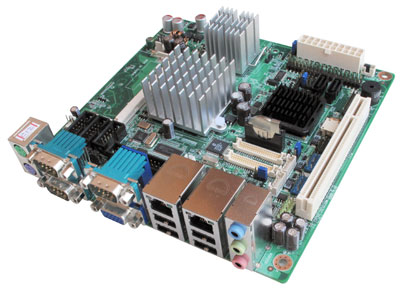
- AIMB-210 SBC Mini-ITX Main board
- CPU heatsink
- CD-ROM with user manual and all drivers
- Cables/connectors for COM3 and COM4
- 40-pin IDE HDD cable
- two SATA data cables
- two SATA power cables
- I/O shield/panel
- all screws needed for mounting the AIMB-210
- A laminated startup manual wit specs, diagrams and jumper settings
Why pick the AIMB-210 Mini-ITX SBC?
Who should be interested in the AIMB-210? In short, anyone building systems that have substantial I/O requirements, including strong legacy support, yet must also run quietly and economically. The AIMB-210 certainly fits the bill here as it offers more connectivity than many full-size boards, and fanless operation doesn't only mean no noise, but also no electric fan that can fail. Atom-based systems also cost a lot less than Intel Core 2 Duo solutions, so if targeted performance at the lowest possible cost is an issue, this board definitely fits the bill.
Keep in mind that as of now, almost all N270-powered boards, including the AIMB-210, use a complementing chipset that is substantially less future-oriented than the chip itself. The Intel 945GSE is a version of Intel's older 945 chipset running at lower frequency (and performance). The chipset's Graphic Medica Accelerator 950 is a tried-and-true design, but it not new and cannot, for example, decode HD signals. That's generally no big deal for vertical market devices, but potential users should be aware of this limitation. The 945GSE does have some interesting features such as the ability to set backlight level automatically in response to ambient light readings to reduce power consumption in low light environments, though not all systems implement all chip and chipset features.
Below is a schematic of the Advantech AIMB-201:
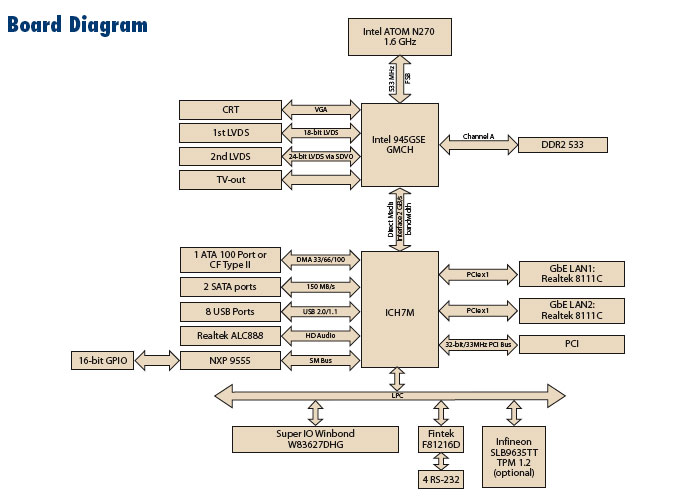
Mini-ITX has come a long way since the early days of the standard. The Advantech AIMB-210 retains the ITX spirit of a simple, flexible, power-efficient board for a variety of embedded and/or industrial applications where small size and efficiency matter, and it does so with extremely power-efficient Intel Atom processor technology.
Advantech AIMB-210 Specs:
| Type |
Mini-ITX Motherboard
|
| CPU Type |
Intel Atom N270
|
| Clock Speed |
1.6GHz
|
| Chipset |
Intel 945GSE + ICH7M
|
| BIOS |
Award 16 Mbit, SPI
|
| Memory |
Max 2GB DDR2 533MHz in 1 200-pin SODIMM socket |
| Graphics Controller |
Intel 945GSE GMCH integrated Graphic Media Accelerator 950 |
| VRAM |
Shared system memory up to 224 MB SDRAM |
| LVDS |
Single channel 18-bit/Dual channel 36-bit LVDS; optional 2nd LVDS: Single channel 18/24-bit/Dual channel 36/48-bit LVDS, via Chrontel 7308B SDVO transmitter
|
| Dual display |
CRT + LVDS, CRT + TV-Out, LVDS + TV-Out
|
| LAN |
2 x 10/100/1000Base-T (Realtek RTL8111C) |
| SATA |
2 x 150 MB/s |
| EIDE |
1 x Ultra DMA 100
|
| SSD |
Compact Flash type I/II slot
|
| USB |
8 x USB 2.0 (4 rear panel, 4 on board) |
| Serial |
3 x RS232 ( 2 RS232, 1 RS232/422/485) |
| Parallel |
1 (internal) |
| Audio |
3 (Mic-in, Line-out, Line-in) |
| DIO |
16-bit GPIO |
| Size |
170 mm x 170 mm (6.69" x 6.69")
|
| Weight |
14 ounces |
| Operating Temp. |
32 to 140 degrees Fahrenheit |
| Price |
US$222 |
| Datasheet |
Advantech AIMB-210 |
| Advantech store |
Advantech Advantech Mini-ITX store |
Advantech Corporation
38 Tesla, Suite 100
Irvine, CA 92618
Toll Free: 1-800-866-6008
Ph: 949-789-7178
Fax: 949-789-7179
ECGInfo@advantech.com
www.advantech.com
Advantech Co. Ltd.
No.1, Alley 20, Lane 26, Rueiguang Road
Neihu District, Taipei Taiwan 114, R.O.C.
Tel: 886-2-2792-7818
Fax: 886-2-2794-7301
www.advantech.com
|



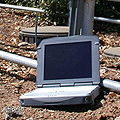

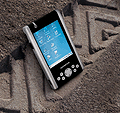
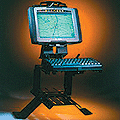





 The Advantech AIMB-210 shown here brings the Intel Atom processor to Mini-ITC motherboards. It includes the 1.6GHz Atom N270 processor that is being used in millions of netbooks, an extremely power-efficient solution with a thermal design power of just 2.5 watts. The board uses an Award BIOS and the Intel 945GSE graphics and memory controller with the ICH7M controller hub. There is a single PCI expansion slot. RAM is provided via one 200-pin SODIMM slot that accommodates up to 2GB of 533 DDR2 SDRAM.
The Advantech AIMB-210 shown here brings the Intel Atom processor to Mini-ITC motherboards. It includes the 1.6GHz Atom N270 processor that is being used in millions of netbooks, an extremely power-efficient solution with a thermal design power of just 2.5 watts. The board uses an Award BIOS and the Intel 945GSE graphics and memory controller with the ICH7M controller hub. There is a single PCI expansion slot. RAM is provided via one 200-pin SODIMM slot that accommodates up to 2GB of 533 DDR2 SDRAM.

